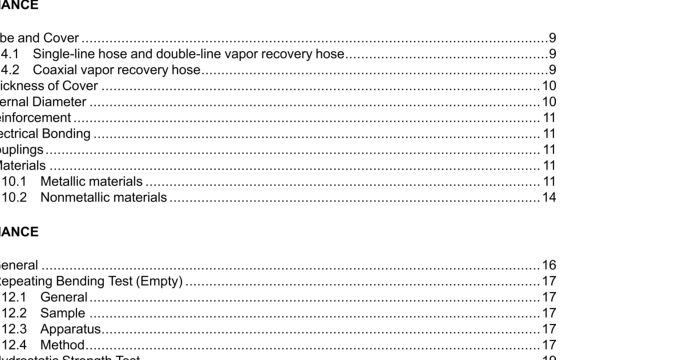UL 330A-2019 pdf download.Hose and Hose Assemblies for Use With Dispensing Devices Dispensing Gasoline and Gasoline/Ethanol Blends With Nominal Ethanol Concentrations Up To 85 Percent (E0- E85).
3.7 LEAST SQUARES FIT LINE — A best fit line drawn through a set of data such that the sum of the squared residuals has its least value, a residual being the difference between an observed value (data point) and the line.
3.8 PERMEATION SURFACE AREA — The length of the hose as determined in 16.5.1 multiplied by the inner circumference of the hose, expressed in square meters. For vacuum-assist vapor recovery hose, the length of the hose is multiplied by the inner circumference of the outer hose. For balance vapor recovery hose, the length of the hose is multiplied by the average inner circumference of the outer hose.
3.9 REINFORCEMENT — Natural or synthetic fibers or fabric, or metallic wire that is wrapped, braided or spiral wound in one or more layers over the tube, intended to provide longitudinal and transverse (hoop) strength to the hose.
3.10 SEAL, DYNAMIC — A seal that is subject to mechanical movement or other applied forces that result in movement or flexing of the seal under normal use conditions.
3.11 SEAL. STATIC — A seal that is not subject to mechanical movement or other applied forces other than compressing forces that are applied during installation and maintained during normal use conditions.
3.12 VACUUM-ASSIST VAPOR RECOVERY HOSE — A coaxial hose consisting of an inner vacuum line for vapor recovery and an outer line. Fuel is dispensed through the annular space between the two lines.
PERFORMANCE
4 Tube and Cover
4.1 Single-line hose and double-line vapor recovery hose
4.1.1 The tube shall be made from a material resistant to the fuels anticipated by these requirements.
4.1.2 The cover shall be made from a material resistant to the fuels anticipated by these requirements and ozone.
4.1.3 The tube and cover shall be of uniform thickness, and free from pitting, blisters, or other imperfections. This requirement is not intended to exclude the use of a corrugated cover.
4.2 Coaxial vapor recovery hose
4.2.1 The tube and cover, if any, of the inner hose shall be made from materials resistant to the fuels anticipated by these requirements.
4.2.2 The tube of the outer hose or a homogeneous outer hose shall be made from materials resistant to the fuels anticipated by these requirements.
4.2.3 The cover of the outer hose or a homogeneous outer hose shall be made from a material resistant to the fuels anticipated by these requirements and ozone. An outer homogeneous thermoplastic hose with no separate layer of reinforcement shall also be made from a material resistant to sunlight.
4.2.4 The tube and cover shall be of uniform thickness and free from pitting, blisters, or other imperfections. This requirement is not intended to exclude the use of a corrugated tube, cover, or outer vapor hose.
5 Thickness of Cover 5.1 The thickness of the cover shall not be less than 0.047 inch (1.19 mm) when measured in accordance with 5.2 – 5.6. Exception: This requirement does not apply to the cover of the inner hose and the outer vapor hose ofa coaxial type vapor recovery hose. 5.2 For removing iregularities in samples, the buffing machine or skiving machine outlined in the Standard Practice for Rubber – Preparation of Product Pieces for Test Purposes from Products, ASTM D3183, is to be used. 5.3 The abrasive wheel of the buffing machine is to be No. 30 – 60 grit and the diameter and rotary velocity of the wheel are to be such that it will have a peripheral speed of 4000 +700 feet per minute (20.3 +3.6 m/s). The machine is to be provided with a slow feed so that very ltte compound can be removed at one cut to avoid overheating of the specimen. 5.4 A dial micrometer graduated to 0.001 inch (0.03 mm) that exerts a load of 2.82 – 3.00 ounces (80 – 85 grams) by means of a weight is to be used to measure thickness. he load is to be applied through a flat contact foot 0.25 +0.01 inch (6.4 +0.3 mm) in diameter. 5.5 To determine the thickness of the tube and cover, a strip, 6 – 8 inches (152.4 – 203.2 mm) long and 1 inch (25.4 mm) wide, or as close to 1 inch (25.4 mm) as possible from small diameter hose, is to be cut longitudinally from the hose, and the part separated from the plies. When the thickness of the part is not uniform around the circumference of the hose, the strip is to be cut from the thinnest portion of the sample. 5.6 The strip specimen is to be buffed or skived to remove the impressions left by the fabric or braid or other surface iregularities, using the equipment described in 5.2 and 5.3. A series of five thickness measurements are to be taken within the area from which the impressions have been removed, and the maximum reading obtained is to be taken as the thickness of the part.UL 330A-2019 pdf download.
UL 330A-2019 pdf download
